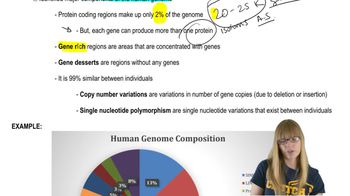Using the data in Table B, calculate the average number of kilobase (kb) pairs per centimorgan in the six multicellular eukaryotic organisms. How would this information influence strategies to clone genes known only by a mutant phenotype in these organisms?
Table of contents
- 1. Introduction to Genetics51m
- 2. Mendel's Laws of Inheritance3h 37m
- 3. Extensions to Mendelian Inheritance2h 41m
- 4. Genetic Mapping and Linkage2h 28m
- 5. Genetics of Bacteria and Viruses1h 21m
- 6. Chromosomal Variation1h 48m
- 7. DNA and Chromosome Structure56m
- 8. DNA Replication1h 10m
- 9. Mitosis and Meiosis1h 34m
- 10. Transcription1h 0m
- 11. Translation58m
- 12. Gene Regulation in Prokaryotes1h 19m
- 13. Gene Regulation in Eukaryotes44m
- 14. Genetic Control of Development44m
- 15. Genomes and Genomics1h 50m
- 16. Transposable Elements47m
- 17. Mutation, Repair, and Recombination1h 6m
- 18. Molecular Genetic Tools19m
- 19. Cancer Genetics29m
- 20. Quantitative Genetics1h 26m
- 21. Population Genetics50m
- 22. Evolutionary Genetics29m
15. Genomes and Genomics
Genomics and Human Medicine
Problem 10
Textbook Question
Describe three major goals of the Human Genome Project.
 Verified step by step guidance
Verified step by step guidance1
Understand that the Human Genome Project (HGP) was an international research effort aimed at mapping and understanding all the genes of the human species.
Identify the first major goal: to determine the complete sequence of the 3 billion DNA base pairs that make up the human genome.
Recognize the second major goal: to identify and map all of the approximately 20,000-25,000 human genes, including their locations and functions.
Note the third major goal: to develop tools and technologies for data analysis and to make the information accessible to researchers worldwide, facilitating advances in medicine and biology.
Summarize these goals by explaining how they collectively aimed to provide a comprehensive blueprint of human genetic information to improve understanding of human biology and disease.
 Verified video answer for a similar problem:
Verified video answer for a similar problem:This video solution was recommended by our tutors as helpful for the problem above
Video duration:
1mPlay a video:
Was this helpful?
Key Concepts
Here are the essential concepts you must grasp in order to answer the question correctly.
Sequencing the Human Genome
This goal involves determining the complete DNA sequence of the human genome, identifying the order of the approximately 3 billion base pairs. It provides a reference map for understanding genetic information and variations across individuals.
Recommended video:
Guided course

Human Genome Composition
Identifying and Mapping Genes
The project aimed to locate and identify all the genes within the human genome, including their positions and functions. This helps in understanding how genes contribute to health, disease, and human development.
Recommended video:
Guided course

Mapping Genes
Developing Tools for Data Analysis and Sharing
Creating computational tools and databases was essential for managing the vast amount of genetic data. This goal ensures that researchers worldwide can access, analyze, and use the genomic information to advance medicine and biology.
Recommended video:
Guided course

Step 2

 6:51m
6:51mWatch next
Master Human Genome Composition with a bite sized video explanation from Kylia
Start learningRelated Videos
Related Practice
Textbook Question
422
views
